Ever wonder if your front door might be screaming “discount” before you even step inside? Some colors just have that uncanny ability to make your home look like it was slapped together on a budget. We’ve rounded up the 12 worst front door hues that could instantly tank your curb appeal. Whether you’re dealing with a neon nightmare or a drab disaster, these shades are more “cheap” than chic. Grab your latte and get ready to cringe at some questionable color choices that even your most experimental friend wouldn’t dare try.
1. Bright Orange

Blinding bright orange is like a firetruck collided with a sunset on your door. It grabs attention in the most aggressive way possible, turning your entrance into an eyesore rather than a welcome. The vivid hue can give off cheap, overdone vibes that seem stuck in a time warp of questionable design choices. A study by HGTV shows that overly bright door colors tend to lower perceived home value. This shade doesn’t just border on gaudy; it leaps over the line into full-blown tackiness. When your door screams orange, it risks making the entire facade look amateurish.
Beyond the immediate shock factor, bright orange is notorious for highlighting every smudge and scratch like a beacon for imperfection. The color seems to draw negative attention rather than complement your home’s architecture. Instead of exuding modern chic, it feels like a remnant of an outdated design fad. Neighbors might wonder if you picked the color to cover up other flaws, adding to its cheap appearance. In a world that values subtlety and balance, blinding orange stands out for all the wrong reasons. It’s a hue that might make your house memorable, but only for its glaring lack of sophistication.
2. Neon Green
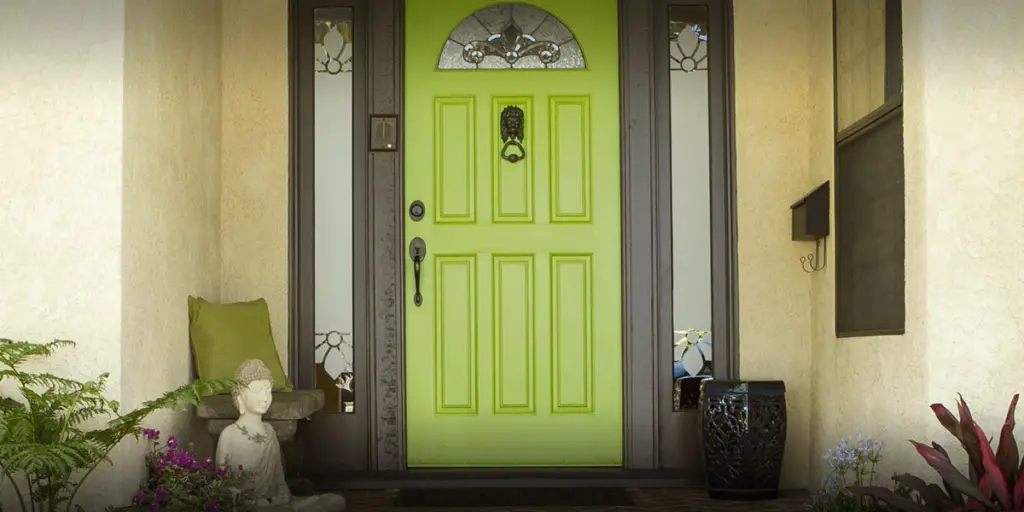
Neon green is like a highlighter gone rogue on your front door. It screams “I’m trying too hard” and makes your home look like a cheap, over-the-top bargain store. The overly bright hue can clash horribly with natural surroundings, making it impossible for your curb appeal to stand a chance. A recent Architectural Digest article reveals that such vibrant shades often detract from the sophistication of a home’s exterior. It’s a color that yells for attention, but in a way that feels more desperate than stylish. When your door is neon green, it can feel like you’re living in a constant highlighter ad.
On top of that, neon green tends to age poorly as trends evolve, leaving your home stuck in an outdated era. Neighbors might roll their eyes at the gaudy display rather than marvel at your boldness. The color is unforgiving, showing dirt and wear in a way that more muted tones might hide. It makes a statement, but not the one you want on your front door. Instead of exuding modern charm, neon green often leaves potential buyers with a sense of regret. It’s a choice that might make you stand out—in all the wrong ways.
3. Murky Brown

Murky brown is like the forgotten remnant of a bygone era on your front door. It can make your entrance appear dull and neglected rather than warm and inviting. The shade often gives off a vibe of cheapness, reminiscent of poorly maintained hardware. According to Better Homes and Gardens, dark, muddied browns can undermine a home’s overall appeal. The color tends to absorb light, making your doorway feel smaller and more claustrophobic. It’s a choice that rarely resonates with modern design sensibilities.
In addition, murky brown is notorious for showing dirt and wear more prominently than cleaner hues. The unappealing tone can make your home seem like it’s perpetually stuck in a state of disrepair. Potential buyers may associate the color with outdated and neglected properties. Rather than evoking a sense of comfort, it leaves an impression of sloppiness. The lack of vibrancy in murky brown can easily make your home look budget-friendly—in the worst way possible. It’s a color that could sabotage your curb appeal and turn a promising entrance into a cheap eyesore.
4. Dull Mustard Yellow
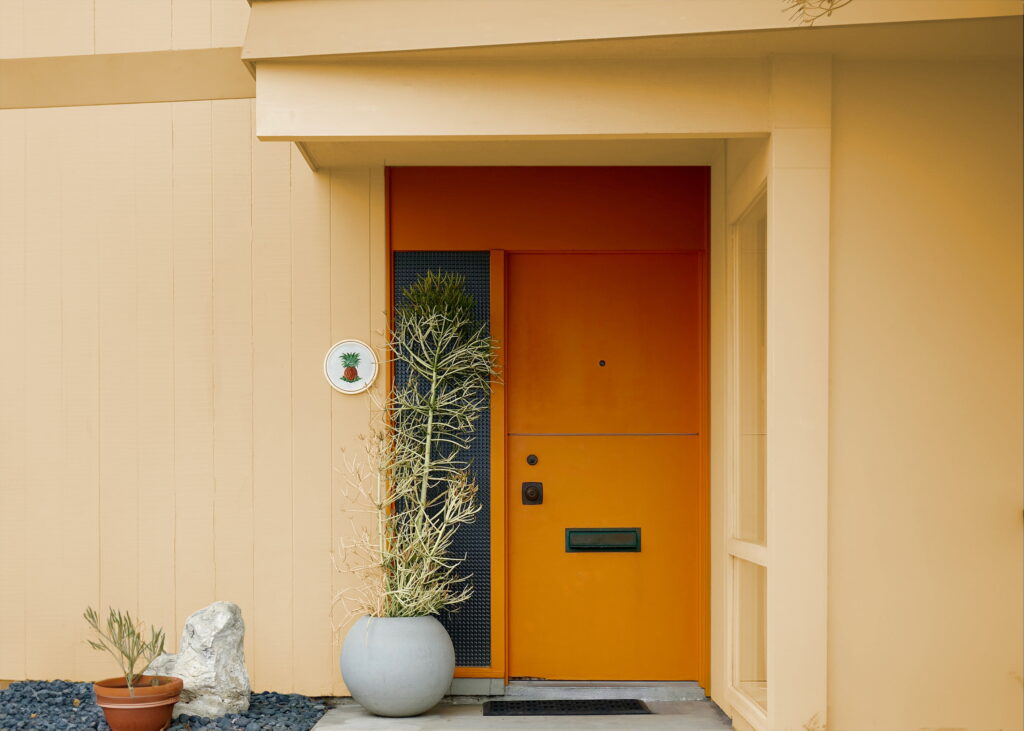
Dull mustard yellow is the kind of color that seems to have peaked in a forgotten ’70s design trend. It exudes an outdated vibe that can instantly cheapen your home’s appearance. Instead of offering a fresh welcome, this hue can make your front door look washed-out and tired. A Realtor.com article notes that modern buyers tend to favor vibrant and contemporary colors over retro, lackluster tones. This mustard shade can often come across as a relic, making your property look like it’s stuck in a time warp. It’s a color that fails to evoke the energy and style of a truly inviting entrance.
Moreover, dull mustard yellow can be a magnet for negative perceptions, hinting at neglect and poor upkeep. The color lacks the sophistication needed to elevate your home’s curb appeal. It ends up highlighting imperfections rather than hiding them. Instead of giving your home a warm, inviting glow, it casts a dull, almost sickly light. Potential buyers might be more inclined to look past your front door if it screams of outdated charm. It’s a risky choice that could ultimately send prospective buyers running for the exit.
5. Pasty, Off-White

Pasty, off-white on a front door might seem like a safe bet, but in reality, it often does more harm than good. The shade can come off as bland, making your entryway look dull and uninspired. It lacks the pop of personality that a modern, stylish door should have. A recent Elle Decor article explains that overly muted colors can sometimes give off an impression of cheapness. This off-white hue tends to reflect a lack of creativity, failing to make a memorable impact. Instead of greeting guests with warmth, it can seem as if your home is hiding behind a bland facade.
Furthermore, pasty off-white can quickly show signs of wear and discoloration, which only adds to its cheap look. The color often fails to mask the inevitable grime and scuffs that come with everyday use. Rather than exuding elegance, it leaves your front door feeling tired and lifeless. The subtle shade does little to boost your home’s curb appeal. Potential buyers might feel underwhelmed by such an uninspired choice. It’s a color that quietly undermines your home’s potential for making a great first impression.
6. Loud Magenta
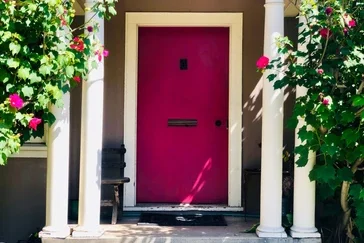
Loud magenta is one of those colors that shouts rather than speaks, and not in a good way. It’s an overwhelming choice that can instantly turn a front door into a spectacle of poor taste. The vibrant hue might work in a high-fashion context, but for a home, it often feels wildly out of place. It can make the overall facade look tacky and overdone, as if you’re trying to stand out for all the wrong reasons. The color clashes with natural elements, drawing unwelcome attention to your entryway. In a world of balanced aesthetics, loud magenta is more of a design misstep than a bold statement.
Additionally, the boldness of loud magenta can quickly become exhausting for both residents and passersby. Its intensity doesn’t age gracefully, often fading into a garish, unappealing tone over time. It gives off an air of amateurish decorating that can lower your home’s perceived value. Instead of creating a warm welcome, it leaves visitors feeling disoriented by its over-the-top nature. The choice seems more like a rebellious impulse than a thoughtful design decision. Ultimately, loud magenta turns your front door into a flashing warning light rather than a stylish greeting.
7. Dismal Gray

Dismal gray might be intended as a neutral, but when it hits a front door, it often comes off as uninspired and lifeless. It fails to make a statement or convey any sense of personality. Instead of serving as a chic backdrop, it dulls the overall appearance of your entry. The color gives off a vibe of neglect, as if your door is perpetually stuck in a gloomy mood. It’s a safe choice that ultimately plays it far too safe, rendering your home forgettable at first glance. Rather than exuding charm, dismal gray leaves everything feeling washed out.
Moreover, dismal gray is notorious for highlighting imperfections like scratches and dents, making them stand out all too clearly. It lacks the warmth and depth needed to balance a modern facade. Homeowners might find that this color does nothing to boost curb appeal—in many cases, it detracts from it. The absence of vibrancy makes the entry feel like an afterthought. Prospective buyers could be put off by such a bland exterior, interpreting it as a sign of neglect. In the end, dismal gray screams mediocrity instead of style.
8. Clashing Turquoise
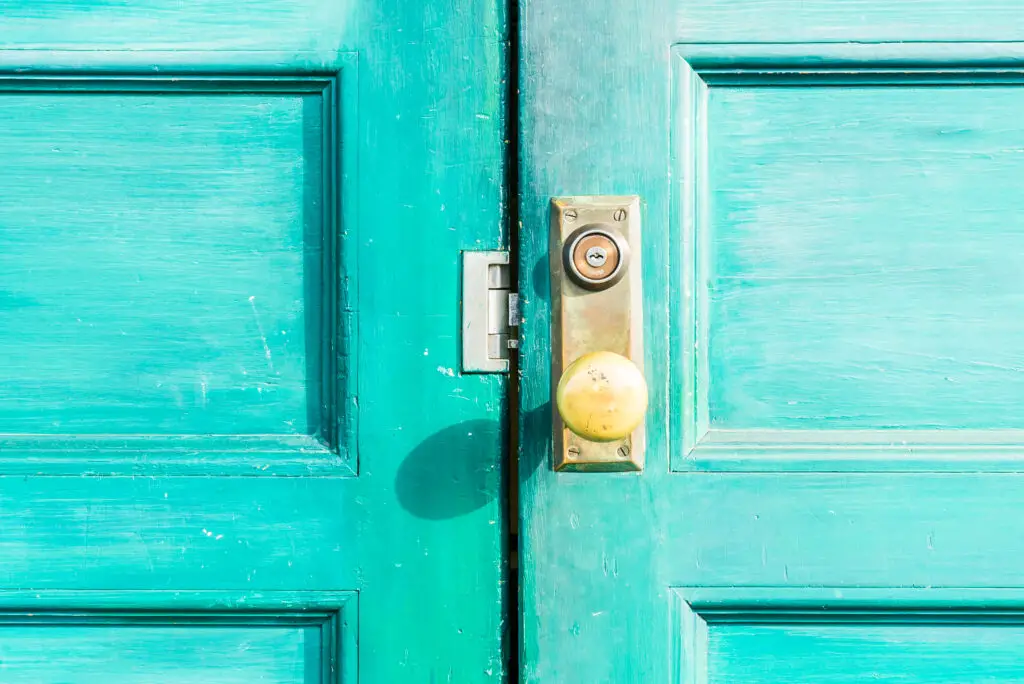
Clashing turquoise is one of those bold choices that might seem fun in theory but often falls flat in practice. It creates visual discord rather than harmony, especially when paired with other elements of your home’s exterior. The shade gives off a mismatched vibe, as if your door is trying too hard to be quirky. Instead of offering a refreshing pop of color, it ends up being an eyesore that disrupts the overall aesthetic. The result is a jarring, disjointed look that leaves visitors scratching their heads. It’s a case of trying to be different but ending up with a design disaster.
Additionally, clashing turquoise can quickly overwhelm more subtle, classic design elements. The intense color may conflict with landscaping and architectural features, creating an unbalanced appearance. It conveys confusion rather than a clear, deliberate style. Homeowners might find that the vibrant shade works against their intended curb appeal. It makes a statement, but not one that potential buyers are likely to admire. Ultimately, clashing turquoise feels like a shout in a world that craves a subtle whisper.
9. Faded Pink

Faded pink might sound charming in theory, but on a front door, it often comes off as tired and worn-out. The color appears washed out, lacking the vibrancy that a fresh coat should have. Instead of evoking warmth and charm, it gives off an air of neglect. The hue makes your door look as though it’s been left to fade under harsh elements. It suggests a lack of upkeep, which can be a major turn-off for potential buyers. The intended softness of pink ends up feeling more like a reminder of faded glory.
Furthermore, faded pink accentuates every sign of aging and wear, highlighting blemishes on the surface. It doesn’t deliver the visual pop needed for an inviting entryway. The color falls short of providing a modern, appealing look and drags the overall appearance down. Neighbors and passersby might question the lack of proper maintenance when they see a door in such a tired hue. Instead of exuding freshness, faded pink leaves an impression of neglect. It’s a subtle misstep that can significantly impact your curb appeal.
10. Sickly Lime

Sickly lime is the kind of color that makes you do a double-take—and not in a good way. It’s an overly bright shade that practically vibrates with an intensity that’s harsh on the eyes. The color is so off-putting that it can make your home look like it came straight out of a discount paint catalog. Instead of offering a modern, crisp look, sickly lime often results in an unappealing, cheap finish. The hue clashes with nearly every other color on your exterior, creating a disjointed effect. It’s as if your door is trying to outshine everything else but ends up failing miserably.
In addition, sickly lime tends to show every smudge and mark, leaving your front door looking poorly maintained. The glare from this color can be overwhelming and detracts from the natural beauty of your home. It feels more appropriate for a neon sign than a refined front door. Homeowners might soon regret the decision when the once-bright shade quickly loses its appeal. Instead of creating an inviting entry, sickly lime turns your door into an eyesore. It’s a bold choice that unfortunately corners you into bad taste.
11. Drab Olive
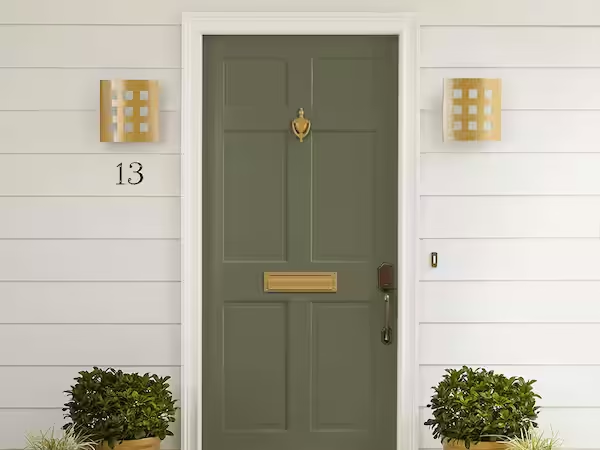
Drab olive might be an attempt at earthy neutrality, but on a front door, it often ends up looking lackluster and uninspired. It’s a shade that fails to make a statement, coming off as dull and forgettable. The color can give the impression of a home that’s been neglected or left to settle in mediocrity. Rather than providing a warm welcome, drab olive leaves visitors with a sense of indifference. It lacks the pop and sophistication that modern design demands. Instead of standing out for its charm, it simply fades into the background in the worst possible way.
Moreover, drab olive is notorious for highlighting dirt and smudges, making any imperfections more visible. The muted tone does little to improve your home’s overall curb appeal. Homeowners might find that this color exudes a sense of settling rather than stylish innovation. Its blandness discourages potential buyers who are looking for a lively, inviting entry. It’s a choice that signals compromise rather than creativity. Ultimately, drab olive makes your front door feel more like an afterthought than a statement piece.
12. Overly Bright Red
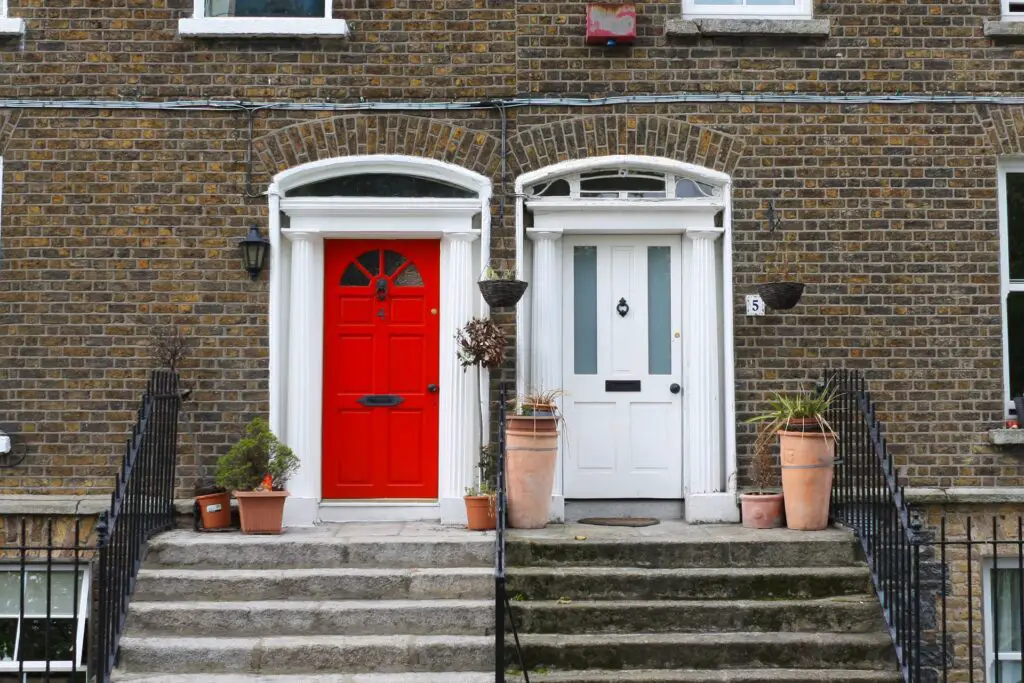
Overly bright red might sound bold on paper, but in reality, it often comes off as gaudy and desperate. The color is so intense that it can transform your front door into a neon sign rather than a refined entryway. It tends to overwhelm architectural details, drowning out more subtle design elements. Instead of exuding confidence, overly bright red makes your home seem like it’s trying too hard to grab attention. The result is an unbalanced look that detracts from the overall curb appeal. It’s a choice that leaves little room for understated elegance.
Furthermore, the aggressive hue of bright red can feel harsh and unwelcoming. It shows every flaw and imperfection, emphasizing wear and tear. The shade clashes with the rest of your exterior design, leading to a chaotic appearance. Neighbors and visitors might see the red door as a sign of poor taste rather than bold style. Its intensity quickly becomes overbearing, making the door the sole focus of an otherwise harmonious facade. Overly bright red ultimately sends a message of desperation rather than chic sophistication.
